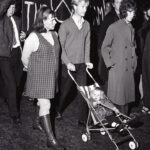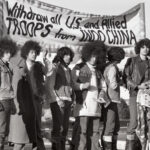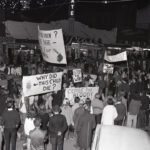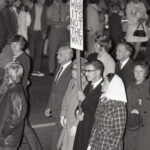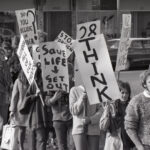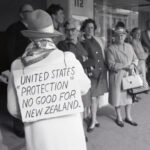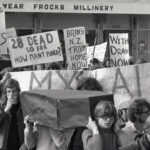Manawatu Exhibition: Peace
The spark that lit the fire of anti-war protest
In 1858–86, France defeated Vietnam and China to secure control over Vietnam and the Indochina region. In 1945, a general uprising brought Ho Chi Minh’s nationalist Viet Minh into power in Hanoi. Ho Chi Minh proclaimed all of Vietnam an independent republic. But France claimed itself the legal ruler of Vietnam and attempted, unsuccessfully, to defeat the Viet Minh militarily.
Flotillas of small boats harassing the warships
After World War II, the United States, France and Britain frequently tested nuclear weapons in the Pacific. In 1959, groups opposed to nuclear weapons, particularly the testing and use of atomic bombs, formed the New Zealand Campaign for Nuclear Disarmament (CND).
Manawatu Photographs
A night-time protest march on May Day 1971 started at the Cathedral and walked through the streets to the Palmerston North Square in narrow formation. John Muir is holding the banner with the peace sign. On the right is Janine Rankin, Manawatū Evening Standard reporter. The peace sign on the banner was originally created for the British Campaign for Nuclear Disarmament in 1958.
Part of the mass protest on May Day 1971. National mobilisations of people from all parts of society took place all over New Zealand, reaching numbers up to 35,000 people by July 1972. They questioned the policies and actions of the United States government, as well as New Zealand’s military involvement.
The night march to oppose the American war in Vietnam on May Day 1971 reaches Broadway Avenue, goes past the State movie theatre and continues to the Square. An estimated 2 million Vietnamese civilians and 1 million soldiers died as a result of the war, which continued until 1975. Two hours after being sworn in as prime minister in November 1972, Norman Kirk confirmed the end of New Zealand military involvement in Vietnam, to be replaced with civil aid. The last NZ troops were withdrawn on 22 December 1972.
Led by their minister, a group from St Andrew’s Presbyterian Church carry a cross in a street march against the American war in Vietnam, Palmerston North, 1 May 1971. In front from left to right: Angus & Gwen Burgess, Rev Iain MacMillan and Margot MacMillan, followed by Alistair, Bob & Rae Kinniburgh. Since 1963 New Zealand had sent medical and humanitarian (civil) aid to Vietnam, including from the government, churches, Red Cross, Corso, World Vision and the Labour Party, some of which continues today.
Thousands march to the Square in Palmerston North in May 1970 calling on the government to withdraw New Zealand troops from Vietnam. Years of protest against military involvement began in May 1965, when, under pressure from the US and Australia, Prime Minister Keith Holyoake announced that a 120-man artillery battery would go to Vietnam.
A large and solemn crowd marches in Palmerston North in May 1970, part of a vocal and extensive anti-war movement throughout New Zealand. Critics of the war in Vietnam accused the New Zealand government of simply doing what the US told it to, and called for a more independent, less submissive foreign policy position.
Peggy Manning hands out information leaflets to passers by in May 1970. Publications, demonstrations, silent vigils, hunger strikes, street theatre, film festivals and teach-ins all contributed to explaining the war in Vietnam to the public.
Thousands march to the Square in Palmerston North in May 1970 calling on the government to withdraw New Zealand troops from Vietnam. Years of protest against military involvement began in May 1965, when, under pressure from the US and Australia, Prime Minister Keith Holyoake announced that a 120-man artillery battery would go to Vietnam.
